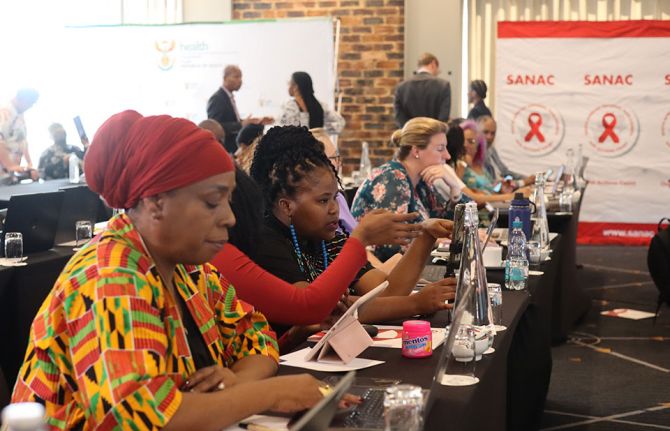
Feature Story
More infants protected from HIV as access to antiretroviral drugs to prevent mother-to-child transmission increases
30 September 2009
30 September 2009 30 September 2009This story has also been published at www.who.int/hiv

Credit: WHO/James Oatway 2009
Despair is giving way to cautious optimism even in the most HIV-affected African nations as antiretroviral drugs become more widely available to stop HIV-positive women from infecting their unborn child or infant, thus edging closer to United Nations targets for an HIV-free generation of children.
The prevention of mother-to-child transmission (PMTCT) is one of the most powerful tools in HIV prevention and has huge potential to improve both maternal and child health. Yet despite recent progress much work remains.
In 2008, 45% of pregnant women in low- and middle-income countries received antiretrovirals to prevent HIV transmission to their child, up from 35% in 2007 and 10% in 2004, according to the 2009 Towards universal access progress report, published by WHO, UNICEF and UNAIDS. In Eastern and Southern African nations, which have the highest rates of infection, coverage jumped to 58% in 2008 from 46% in 2007, thanks to increased national commitment and focused international support.
One important reason is that HIV testing and counselling among pregnant women is increasing with the expansion of provider-initiated approaches in health-care settings. In 2008, 21% of pregnant women giving birth in low- and middle-income countries received an HIV test, up from 15% in 2007. In sub-Saharan Africa, the corresponding percentage rose from 17% to 28%, with particularly high rates of increase in countries in Eastern and Southern Africa. This was partly due to an increase in antenatal facilities providing PMTCT services and attracting high first-visit turnouts by pregnant women.
Globally, AIDS is the leading cause of mortality among women of reproductive age. In 2008, an estimated 1.4 million pregnant women living with HIV gave birth, 91% of them in sub-Saharan Africa, according to the report. One third of children living with the virus die before the age of one year and almost half by the second year.
In 2008, 70 low- and middle-income countries had established a national scale-up plan with population-based targets to prevent mother-to-child transmission of HIV, up from 34 countries in 2005. 54 countries had plans to scale up paediatric HIV services in 2008, compared to 19 countries in 2005. An estimated 32% of the infants born to HIV-infected mothers in 2008 were reached with antiretrovirals, more than five times as many as in 2004.
UN recommendations on PMTCT are based on a four-pronged approach: primary prevention of HIV infection among women of childbearing age; preventing unintended pregnancies among women living with HIV; preventing HIV transmission from women living with HIV to their infants, and providing appropriate treatment, care and support to mothers living with HIV and their children and families.
The UN General Assembly has set a target for 80% of pregnant women and their children to have access to essential prevention, treatment and care by 2010 to reduce the proportion of infants with HIV by 50%. This would entail at least 500 000 additional pregnant women accessing PMTCT services in order to meet this target. Given that PMTCT represents the interface between HIV and maternal and child health services, this would have a positive impact on the health of women and children in general. Achieving the target remains a formidable challenge, but more and more countries are making strides in the right direction.
Botswana, long regarded as sub-Saharan Africa’s flagship in prevention, treatment and care, has easily surpassed the target, with an estimated 95% of HIV-positive pregnant women and their newborns receiving testing, counselling and antiretrovirals. PMTCT has long been one of the pillars of national prevention programmes, according to WHO country representative Eugene Nyarko. “Government commitment and responsibility has been key,” he says.
Huge progress has been made in Swaziland, which has the world’s highest HIV prevalence. More than 90% of pregnant women in public health facilities now receive counselling and testing, and most of those testing positive are given antiretrovirals, according to Derek von Wissel, director of Swaziland’s National Emergency Response Committee on HIV/AIDS. “The availability of treatment is a huge positive element. People are not as fearful of testing since they know that HIV is no longer a death sentence and that there are remedies.” Swaziland has cut its mother-to-child HIV transmission rate from a peak of more than 30% to around 20%, and the goal is to reduce it to 5% by 2014, says von Wissel. “In Botswana, the paediatric programme is slowing down because fewer and fewer infants are being infected with HIV. We will hopefully go in that direction as well,’’ he says.
Equally significantly, more countries are following WHO recommendations to use a combination of two or three antiretroviral drugs to prevent vertical transmission from mother to child. In 2007, 49% of women receiving antiretrovirals were given a single-dose regimen of nevirapine. By 2008, this had fallen to about 31%, with more women receiving the more efficacious combination of several antiretrovirals.
A survey of babies tested for HIV during routine immunization in South Africa’s KwaZulu-Natal province showed the six-week vertical HIV transmission rate was 7% in 2008/2009 compared to 20.8% in 2004/2005. The dramatic reduction was largely due to an increase in testing, counselling and treatment and the switch to a combination of more than one antiretroviral drug.
“These data demonstrate that effective antiretroviral interventions can be delivered at scale and transmission rates can be dramatically reduced,” according to the Towards universal access progress report. “From where we were five years ago, there has been a tremendous increase in coverage,” comments Hoosen Coovadia, one of the South Africa’s top professors of paediatrics and PMTCT scientists. But he says capacity constraints at local level remain a challenge, and that health authorities should do more to use PMTCT as a catalyst to widen reproductive health services and involve male partners.
Progress in general in Western and Central Africa was held back by low coverage levels in Nigeria and the Democratic Republic of Congo which bear the heaviest HIV burden in the region. Nigeria alone accounts for 30% of the global gap in the UN’s target of reaching 80% of women by 2010.
In North Africa and the Middle East, less than 1% of pregnant women living with HIV received an antiretroviral regimen to stop HIV transmission to their child. In East, South and South-East Asia the figure was 25%. Coverage in Latin America increased from 47% in 2007 to 54% in 2008, and in the Caribbean from 29% to 52%. In Europe and Central Asia, coverage jumped from 74% in 2007 to 94% in 2008.
Even in countries with strong PMTCT programmes, there is no room for complacency. Thailand, for instance, has cut mother-to-child transmission rates to less than 5%, according to Siripon Kanshana, Deputy Permanent Secretary in the Ministry of Public Health. But she says there is a need for further capacity building and more training of medical personnel—nurses in particular—in testing and counselling and in monitoring side effects of antiretrovirals and potential drug resistance. “The Ministry of Health has the commitment. But the government still needs advocacy from UN agencies to help strengthen our health care systems to cope.”
More infants protected from HIV as access to anti
Cosponsors:
World Health Organization (WHO)
United Nations Children’s Fund (UNICEF)
Press centre:
More than four million HIV-positive people now receiving life-saving treatment (30 September 2008) (pdf, 40 kb.)
Feature stories:
Evidence shows new drug combination dramatically reduces mother-to child transmission of HIV during breastfeeding (22 July 2009)
Lesotho: HIV free babies bring hope (16 July 2009)
Early diagnosis and treatment save babies from AIDS-related death (27 May 2009)
Publications:
Towards Universal Access: Scaling Up Priority HIV/AIDS Interventions in the Health Sector (pdf, 3 Mb.)
UNAIDS Outcome Framework 2009-2011 (pdf, 388 Kb.)



